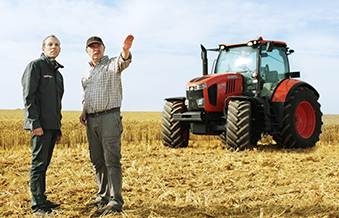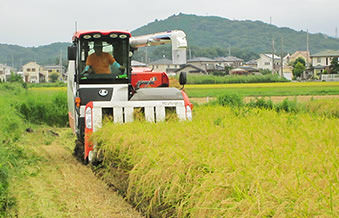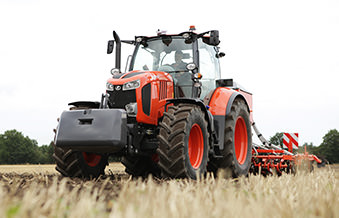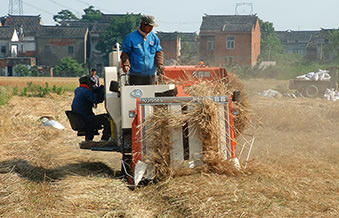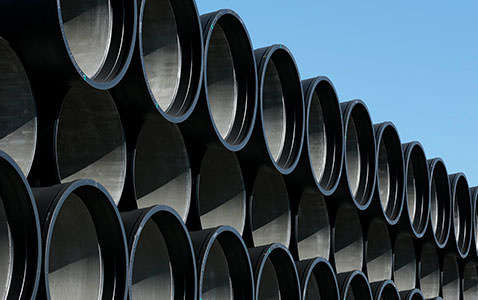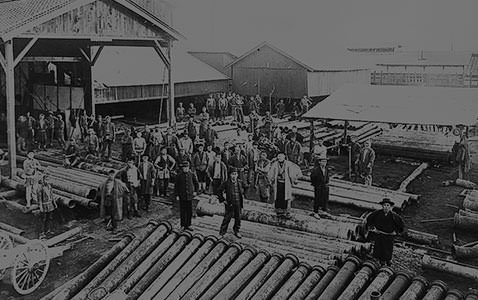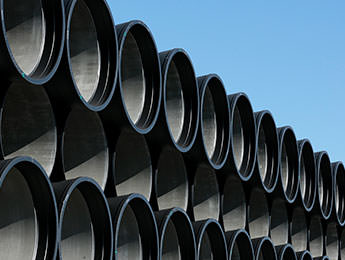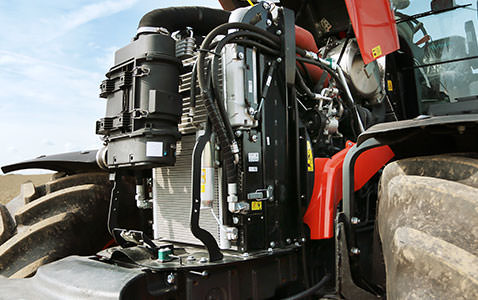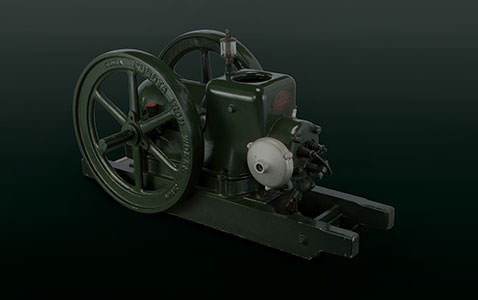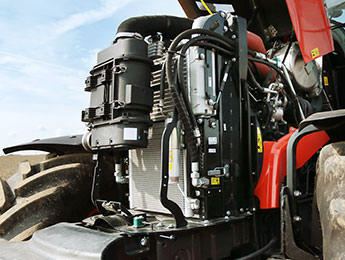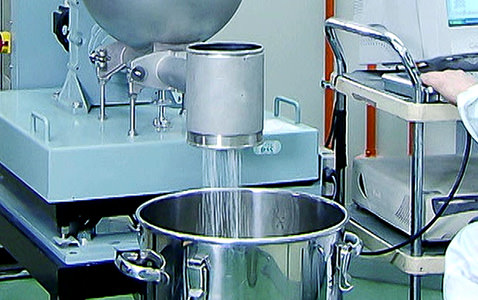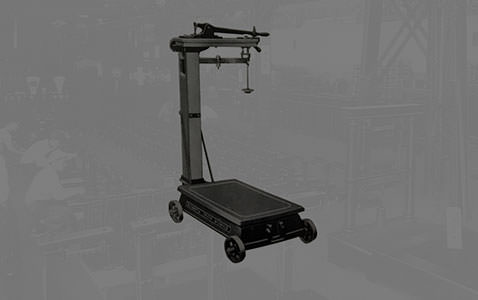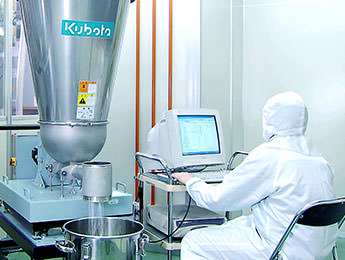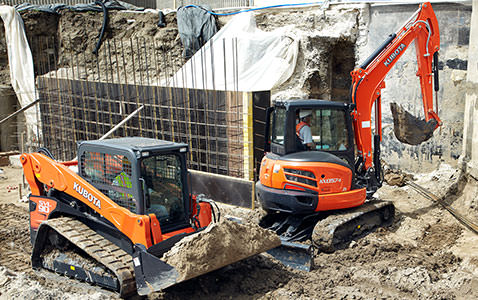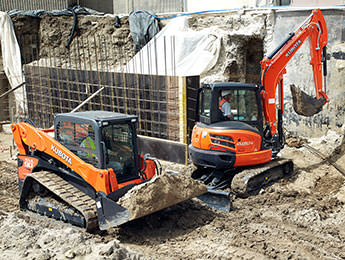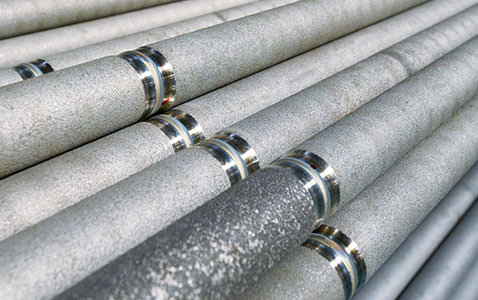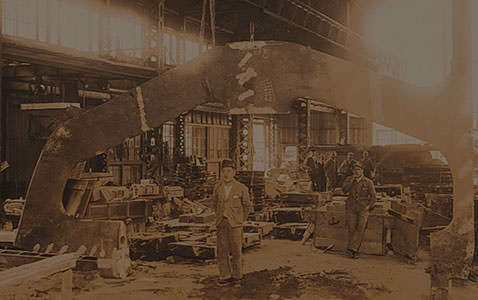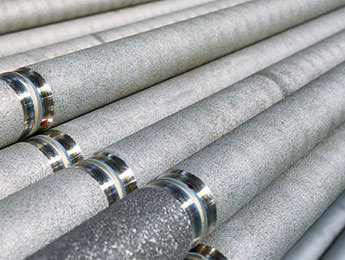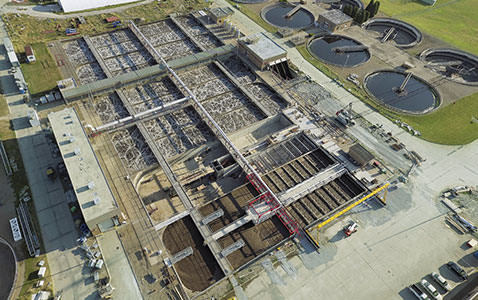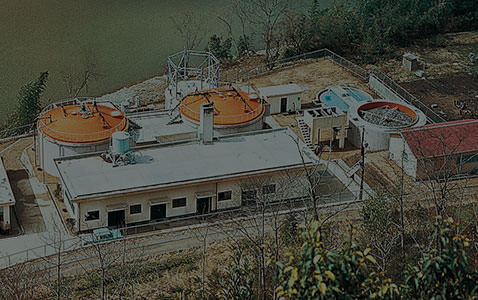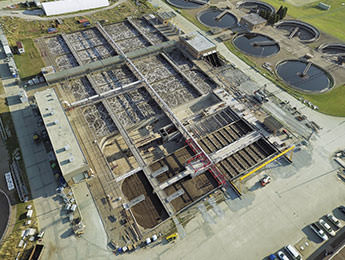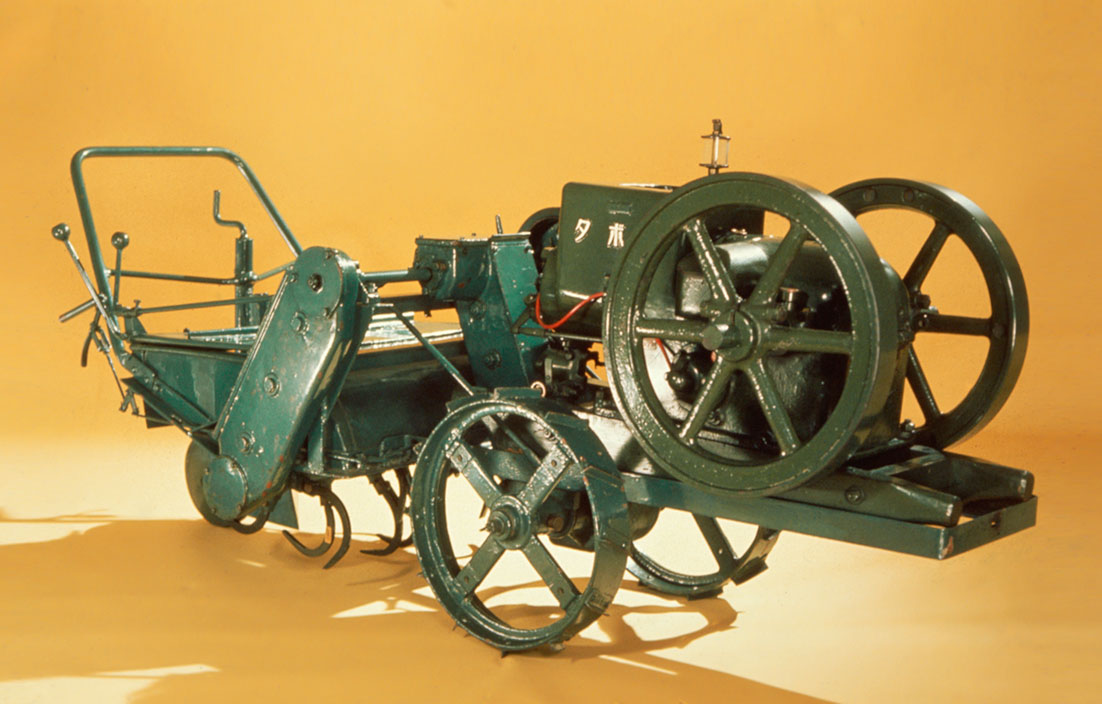
1940-1950s
Supporting Increased Food Production
After World War II and Pioneering
in Agricultural Mechanization
Cultivator
The first cultivator (K1 Type Kubota Rotary Cultivator)
Kubota contributed to Japan’s post-war reconstruction by promptly resuming its operations for manufacturing agricultural engines and casting for chemical to be used in fertilizer plants, in line with the national policy to secure food. In 1947, we developed a cultivator. In what may be called the dawn of agricultural mechanization, Kubota declared itself to be a pioneer of the industry.
Resuming the Production of Engines and Research of Cultivators in Order to Save the Nation from Famine
Many people in Japan suffered from hunger with food scarcity caused by unseasonable weather conditions and lack of labor force. When the government passed an emergency measurement supporting first-rate farmers and an agrarian reform bill, allowing many landowners to farm on their land, private use of engines rose. As its use expanded to areas such as irrigation and rice hulling and the demand for engines increased, Kubota resumed its oil engine manufacturing operation at the Sakai Plant in September, 1945. It helped Japan overcome its crisis by manufacturing products that supported increased food production, such as agricultural engines and fertilizer plants’ casting for chemical In time, as the agricultural machinery industry started to thrive, it resumed its research for cultivators, which was discontinued during the war.
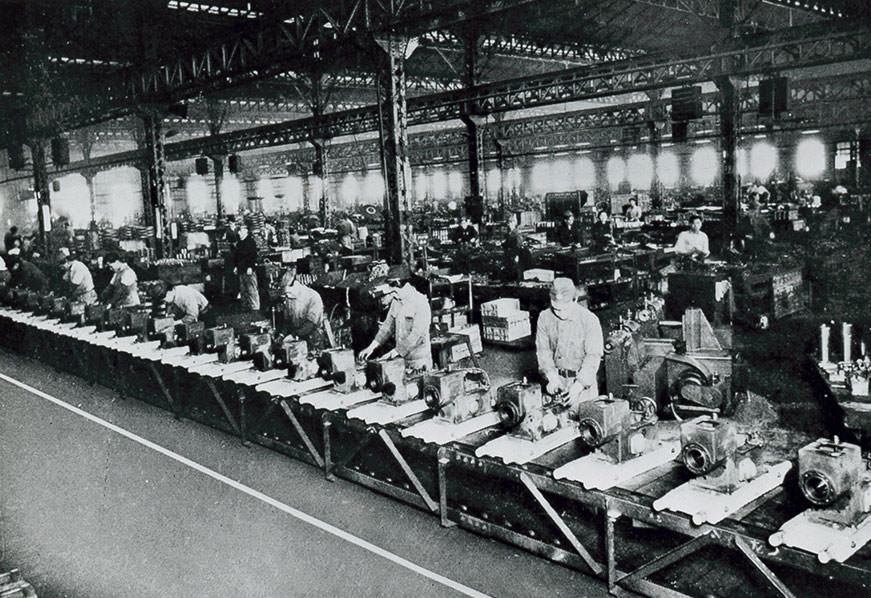 Engine assembly line in the Sakai Plant
Engine assembly line in the Sakai Plant
Kubota Leading Japan’s Agricultural Mechanization. Reforming the Distribution System, Kubota Solidified the Foundation for Further Development of its Agricultural Machinery Business
In 1947, we established Asahi Industrial Co., Ltd. (currently: Kubota Precision Machinery Co., Ltd.). In May of this year, employing state-of-the-art automotive engineering technology, we created the first prototype cultivator. The machine was shown at the First National Agricultural Mechanization Exhibition and soon went on sale as the K1 Type Kubota Rotary Cultivator. In 1948, the enhanced K2 Type Kubota Rotary Cultivator won the Grand Prize at the National Competition for Power Cultivator Demonstration. However, this was long before cultivators were popularized, and the company had to wait until the 1960s for the business to flourish. This year, we established our own distribution system, integrating production, sales and service of our agricultural machinery products. This became the foundation for the future development of our business.
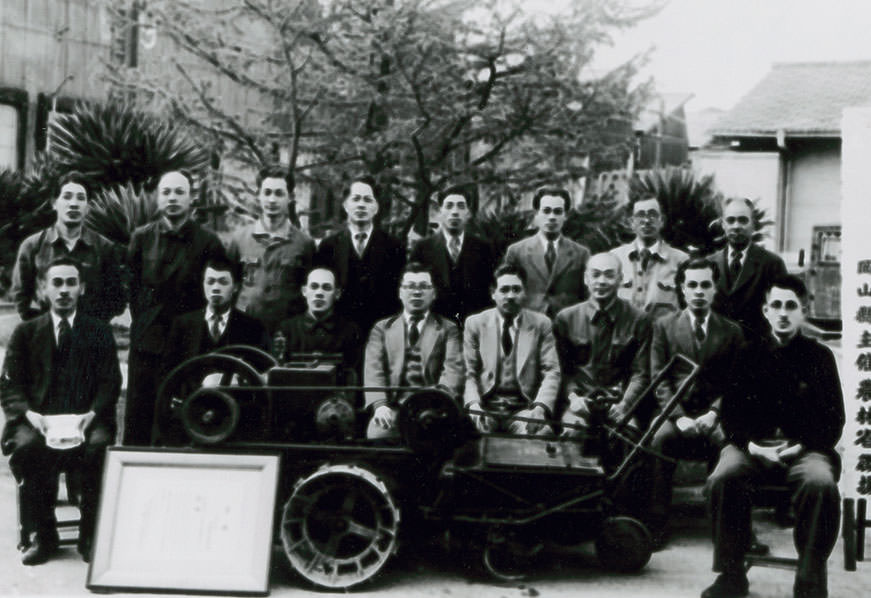 Received Grand Prize at the National Competition
Received Grand Prize at the National Competition
for Power Cultivator Demonstration
1950-1960s
The Two Sides of Rapid Growth.
The Outflow and Creation of Agricultural Workforce
As the Japanese industrial structure changed with rapid growth and large populations all of sudden moved to urban areas, rural regions faced severe labor force shortage. In order to support the rural communities, Kubota advanced its efforts to improve and develop agricultural machineries. We developed domestic tractors for dry-field farms as well as rice paddies that responded to the needs of Japanese farmers, distinct from those imported from the United States and Europe.
Scroll down
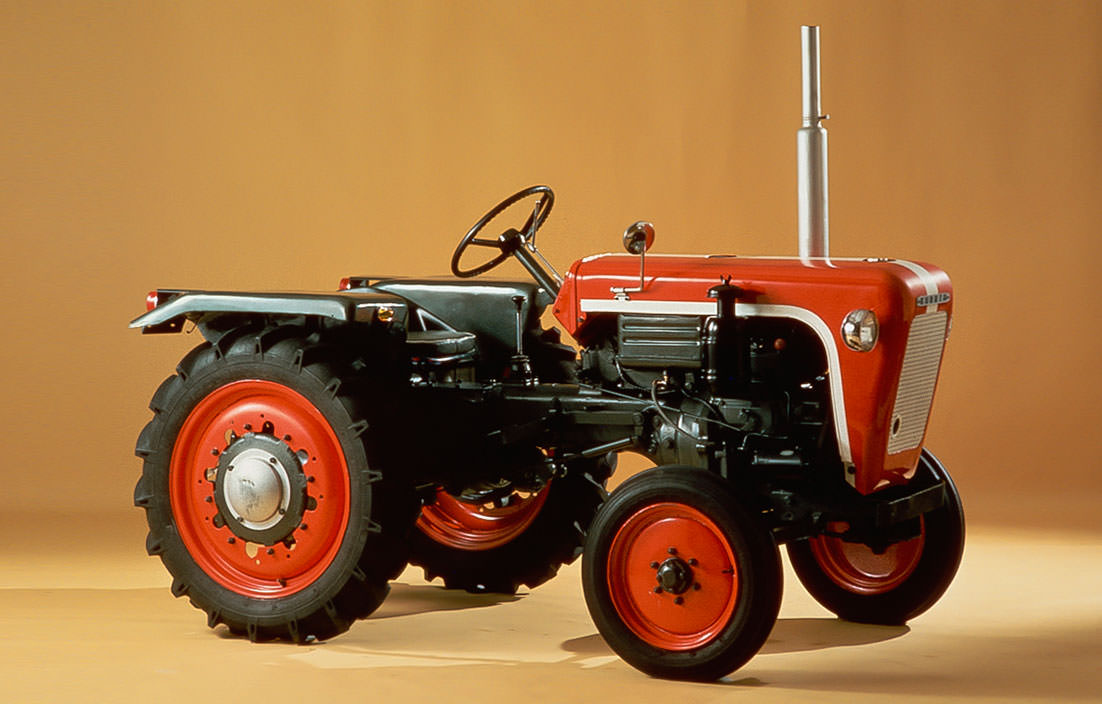
1950-1960s
Standing by the Farmers,
the First Domestic Tractor is Born
Tractor
The First Domestic Dry-Field Farming Rider Driven Tractor Type T15
In 1958, the company’s Agricultural Machinery Division greatly expanded its business, surpassing the Iron Pipe Division in sales volumes. Despite developments in the industry, the rural regions suffered from the loss of labor force, due to massive outflow of population to urban areas experiencing rapid economic growth. In order to support the rural communities, Kubota developed domestic tractors for dry-field and rice farming.
Changes in Industrial Structure and Sudden Flow of Population from Rural to Urban Areas Brought on by Rapid Economic Growth
Based on the 1955 corporate slogan “From Country Building to Rice Making,” the Agricultural Machinery Division achieved tremendous growth. In time, its sales surpassed that of the Iron PipeDivision, expanding its network with the establishment of direct distribution and service stations in all the major cities in Japan over 10 years. This was amid Japan’s rapid economic growth. In contrast to the development of the agricultural machinery industry, rural farming communities suffered from the efflux of population, due to urbanization and industrialization. In order to support farmers struggling with labor force shortage, Kubota hastened its improvement and development of agricultural machinery. In 1960, the number of cultivators used in Japan’s fields counted 745,792.
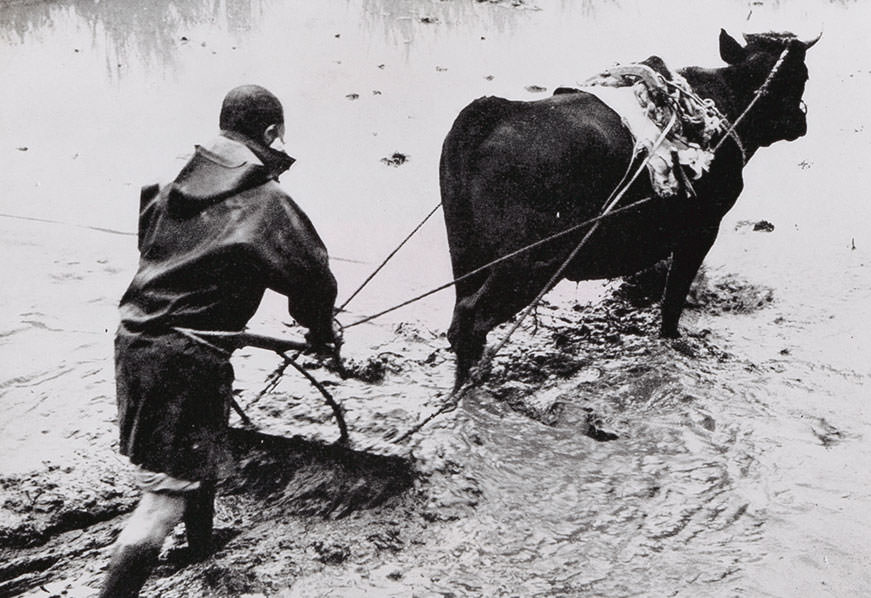 Puddling work with an ox on a rice field
Puddling work with an ox on a rice field
Introduction of the First Domestic Tractor, Creating Power and Efficiency that Replaces Manpower. Kubota’s Innovation, Standing by the Farmers
As demand for cultivators rose, large tractors from Europe and the US were introduced around 1956, mainly in Hokkaido. However, as these tractors were out of proportion to the scale of Japanese farming, Kubota meticulously pursued an original structure with features that suited Japan’s farming practices and economy. Kubota’s engineers stayed at farmers’ for days and studied their needs. After many trials and rigorous testing for continuous operation and durability, in 1960, we created a purely domestic Type T15 Dry-Field Farming Rider Driven Tractor with an engine and structure that met the needs of Japanese farmers. Furthermore, using the technology to develop cultivators, the company created the Type L15R Rice Field Farming Tractor in 1962. In this way, Kubota supports the creation of agricultural labor force.
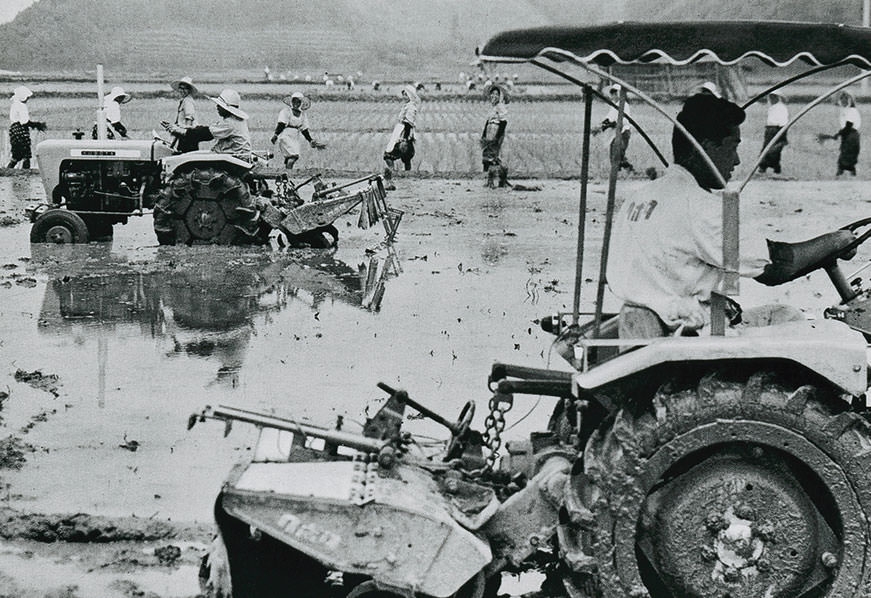 The Type L15R Rice-Field Rider Driven Tractor employed in a rice paddy
The Type L15R Rice-Field Rider Driven Tractor employed in a rice paddy
1960-1970s
The Arrival of an Agricultural Machinery Boom
Caused by Worldwide Food Shortage
As demand for agricultural mechanization rose since the period of rapid growth, the world started showing signs of food shortage. In response, Japan’s agricultural machinery experienced a boom. In time, the industry went through a transition phase in which agricultural work became a “driving work” rather than a “walking task,” and the use of tractors and combines spread drastically, becoming internationally strategic products.
Scroll down
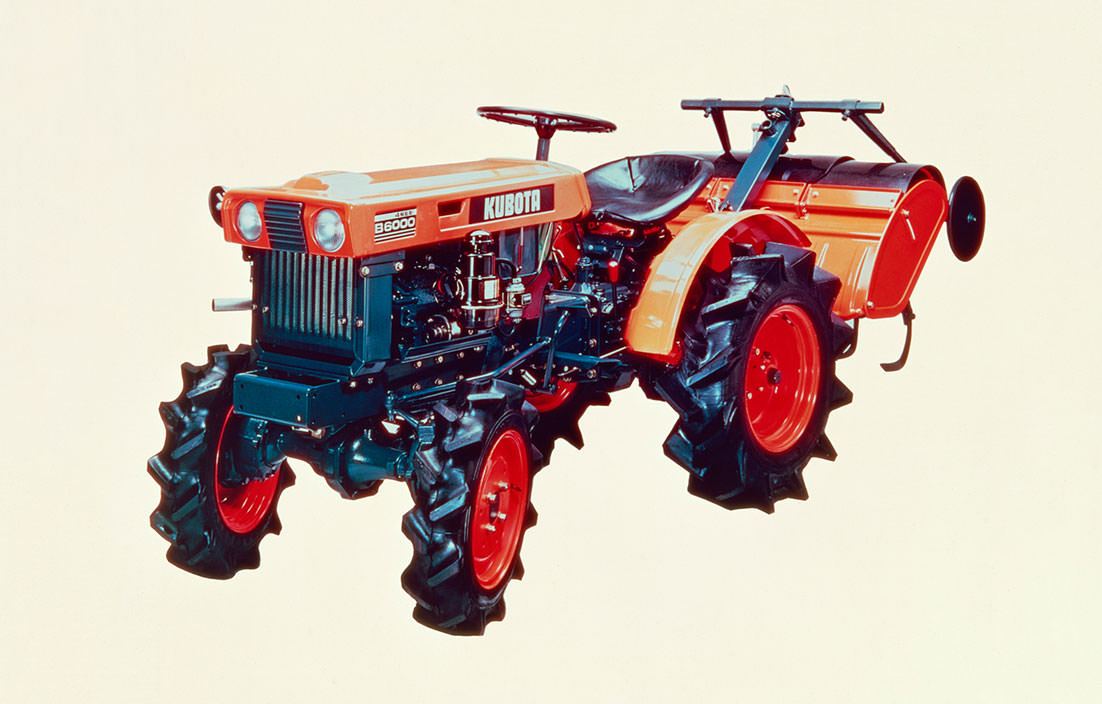
1960-1970s
Tractors and Combines Play the Leading
Role in Growth. A Transition to Agriculture,
From Walking Task to Driving Work
Tractor, Rice Transplanter, Binder, Combine
The ultra-compact 4-wheel drive tractor Bulltra B6000
The demand for agricultural machinery continued to rise as the Japanese industrial structure dramatically changed during the rapid growth period. Since 1972, the world showed signs of food shortage due to unseasonable weather. In Japan, agricultural policies were revised and the agricultural machinery industry boomed—the era of the “tractors and combine harvesters.”
A Decreasing Agricultural Population and the Further Rise in Demand for Agricultural Machinery as Well as Expectations and Needs for Agricultural Mechanization
After rapid economic growth, population of labor force in rural farming communities continued to decline. As increasing number of farmers took on second jobs or started employing female and elderly people, the demand for agriculture machinery as well as further mechanization of agriculture continued to grow. Standing close to the farmers facing such challenges, Kubota, who was developing reaper-binders at the time, was first to introduce to the industry its HC75 Type 3-Row Reaper-Binder in 1965 after 10 years of trial and error. The binders were built to suit both the physical characteristics and the economy of the regions they were going to be used in. Thus, with a thoroughly developed plan, Kubota shipped 550 test binders, assigning one operator to one machine.
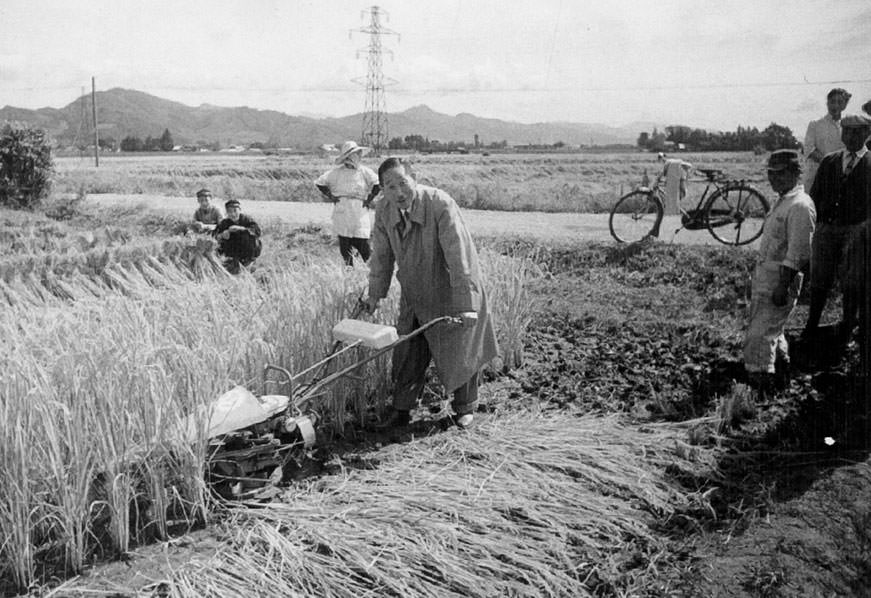 Testing of the HA1 Type Reaper-Binder.
Testing of the HA1 Type Reaper-Binder.
It took Kubota 10 years to develop the machine.
Performance 15 Times That of Manpower — With the Spread of Kubota Reaper-Binders, Rice Harvest Recorded Its All-Time High
In 1967, two years after the trial sales, Kubota determined the price and manufacturing system for a limited ten thousand binders, reflecting the input from farmers. People eagerly anticipated the full release of Kubota binders, which provided performance 15 times that of manpower. Next, demand further expanded when Kubota released the HC50 Type 2-Row Reaper-Binder for small-scale farmers working on land about 1ha in size. The more than 5,000 binders produced every month contributed to the greatest rice crop yield back then. For the research and development of these small reaper-binders, Kubota received, the first among private entities, the “Mori Technical Award” , an award that recognized and honored excellence in the development of agricultural machinery in Japan.
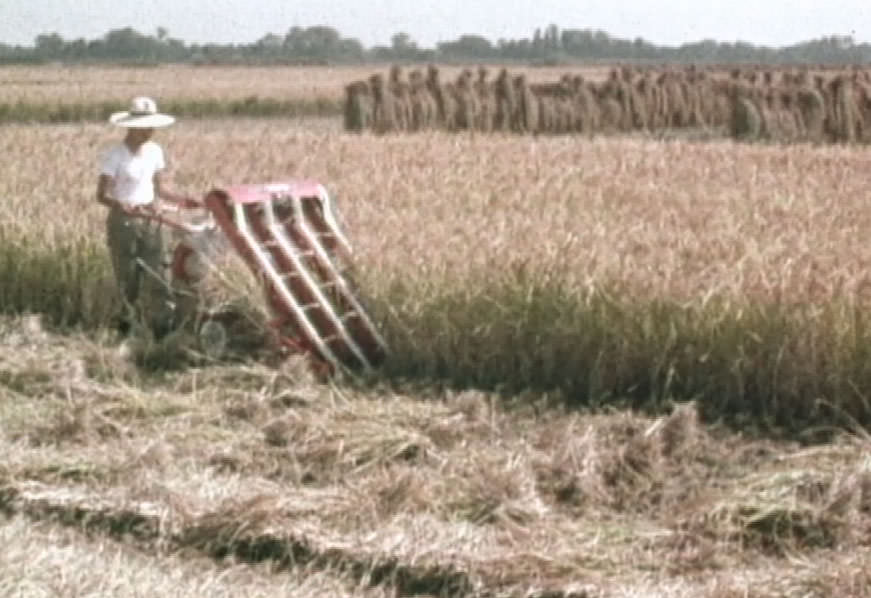 Small-scale binders dramatically improved the efficiency of reaping
Small-scale binders dramatically improved the efficiency of reaping
Realizing the Long-Cherished Dream of Rice Farmers — Finally Mechanizing the Intense Farm Labor. The Introduction of Rice Transplanters
The mechanization of rice transplanting has long been a dream of rice farmers. Since the Meiji Era, many attempts have been made; however, none were actualized, and development has proven to be extremely challenging. Distinct from its competitors’ approach, Kubota focused on developing a transplanter that “transplanted the soil holding the seedlings” raised first by “scattering seeds” on seedling trays. In 1968, we developed the SP Type, and, the following year, released the single wheel, 2-row SPS Type planter, which later formed the basis for the walking-type rice transplanters. In 1970, we began its/their mass production. As this method to raise seedlings by “scattering seeds” in a tray has many advantages and reduces the space of raising seedlings into 1/20, most manufactures later adopted this method.
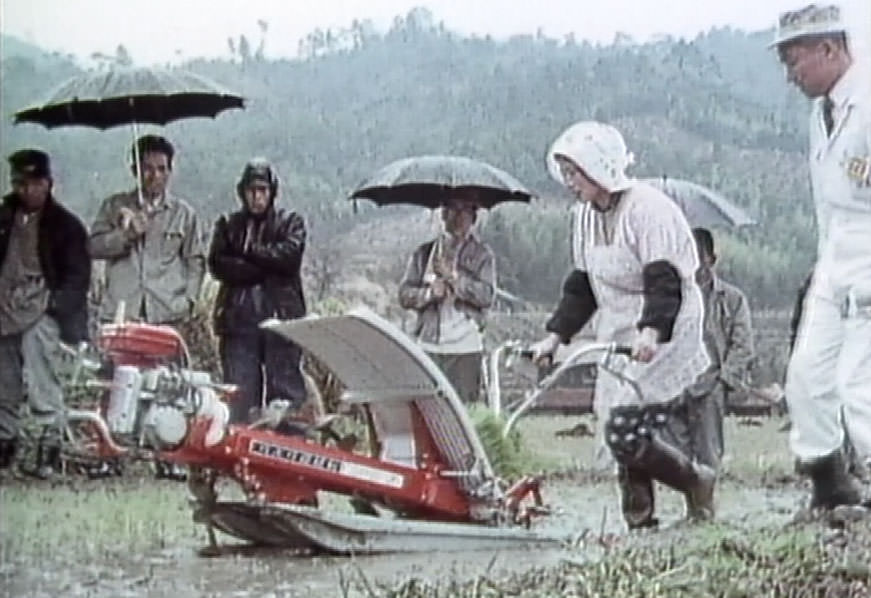 Kubota’s Type SPS Rice Transplanter became the model for rice planters
Kubota’s Type SPS Rice Transplanter became the model for rice planters
The Opening of an Agricultural Machinery Manufacturing Plant in Utsunomiya, Maintaining and Expanding Shares by Alternating Production for Spring- and Fall-Time Demands
In the latter half of the 1960s, rice planting, reaping and harvesting was mechanized one after another. It was a time when rice yield had been at a record high for three consecutive years, and the popularity of binders rose sharply. In order to respond to this demand, Kubota built a binder manufacturing plant in Utsunomiya City, Tochigi Prefecture, in 1969, spending 4 billion yen—an extraordinary investment for a single plant. The mass-production facility for rice tranplanters was completed the following year. This allowed the company to alternately produce reaper-binders required in the fall and rice transplanters required in spring every half year. In time, the demand for combine harvesters increased, leading to the opening of a combine harvester manufacturing plant in 1974. Accommodating facilities specializing in agricultural machinery, the Utsunomiya plant supported Japan’s agricultural machinery demands.
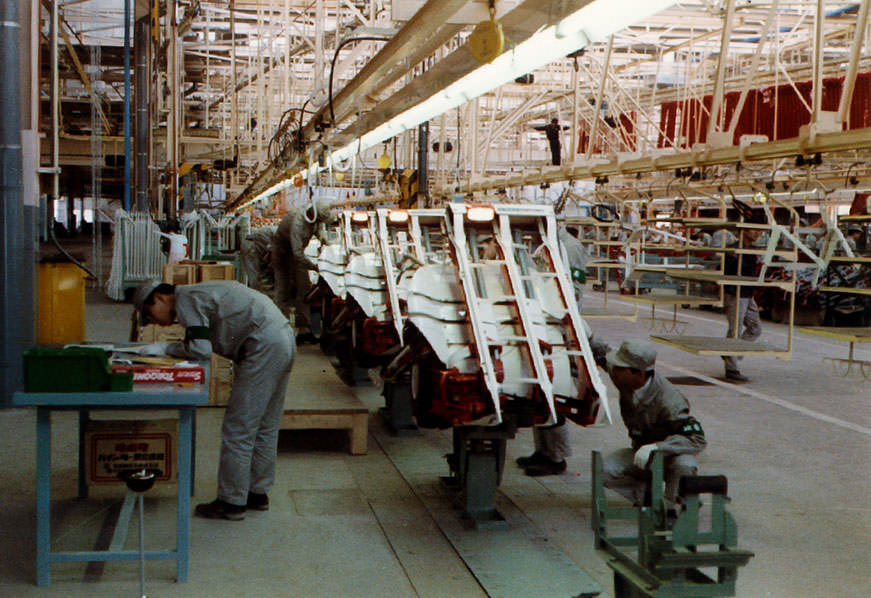 The binder production line in Utsunomiya, which responded
The binder production line in Utsunomiya, which responded
to the sudden rise in demand
The Arrival of an Agricultural Machinery Boom Caused by Worldwide Food Shortage — Sudden Rise in Demand, Creating Lines in Front of Stores Since Early Morning.
While rice harvest had been at a record high from 1967 for three consecutive years, the Japanese people started to veer from a rice-based diet with the diversification of eating habits. Assessing the inventory of rice from previous year’s crops, the government ordered production adjustments. This resulted in the drop of demand for agricultural machinery, which was recording high growth until then; however, sales recovered in a year. In 1972, as the world faced food shortage due to unseasonable weather, Japan revised its agricultural policies and raised the government’s buying price of rice. In response, the agricultural machinery industry boomed. As many had held back on purchasing machinery, their needs for high performance machineries grew at once, for rice transplanters, reaper-binders, tractors, and combine harvesters.
A Transition of Agriculture from a “Walking Work” to a “Driving Work.” Tractors and Combines Play the Leading Role in High Growth.
The Ultra-Compact 4-Wheel Drive Tractor B6000 (“Bulltra”) released in 1971 was designed as a four-wheel drive, which performed better in muddy surfaces such as paddy fields, receiving high reputation from farmers. This had a major impact on the industry, where four-wheel drive system became the standard for tractors since then. The 2-Row Combine Harvester HX55, which was released in the same year, removed the need for manually reaping the ridges of the field, leading to explosive sales of combine harvesters. The times had changed from agriculture being a “walking work” to a “driving work,” and with the vision of manufacturing globally competitive tractors, one of the world’s leading plant was built in Tsukuba. It was a major development for the company, overcoming the “oil shock.”
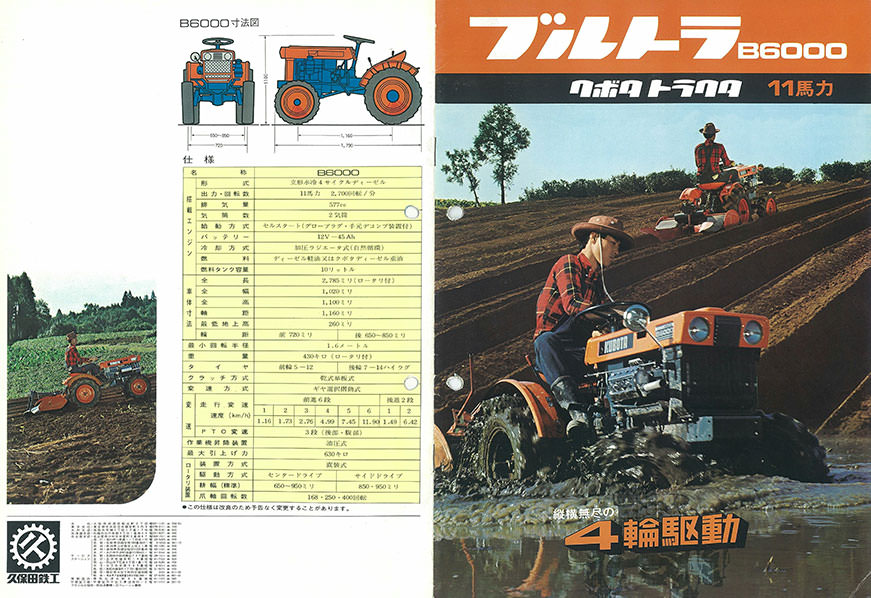 The Ultra-Compact 4-Wheel Drive Tractor B6000
The Ultra-Compact 4-Wheel Drive Tractor B6000
with excellent runnability and functionality
1970-1980s
Transition of Time — From Selling Machinery to Selling Services
In 1980, Kubota revised its corporate slogan to “Pursuing a promised future with our technological strength,” as it celebrated its 90th anniversary of its founding. As times changed from selling machinery to selling services, we reaffirmed our commitment to stand by our customers and provide heartfelt services. We created a new tide in the matured agricultural machinery market.
Scroll down
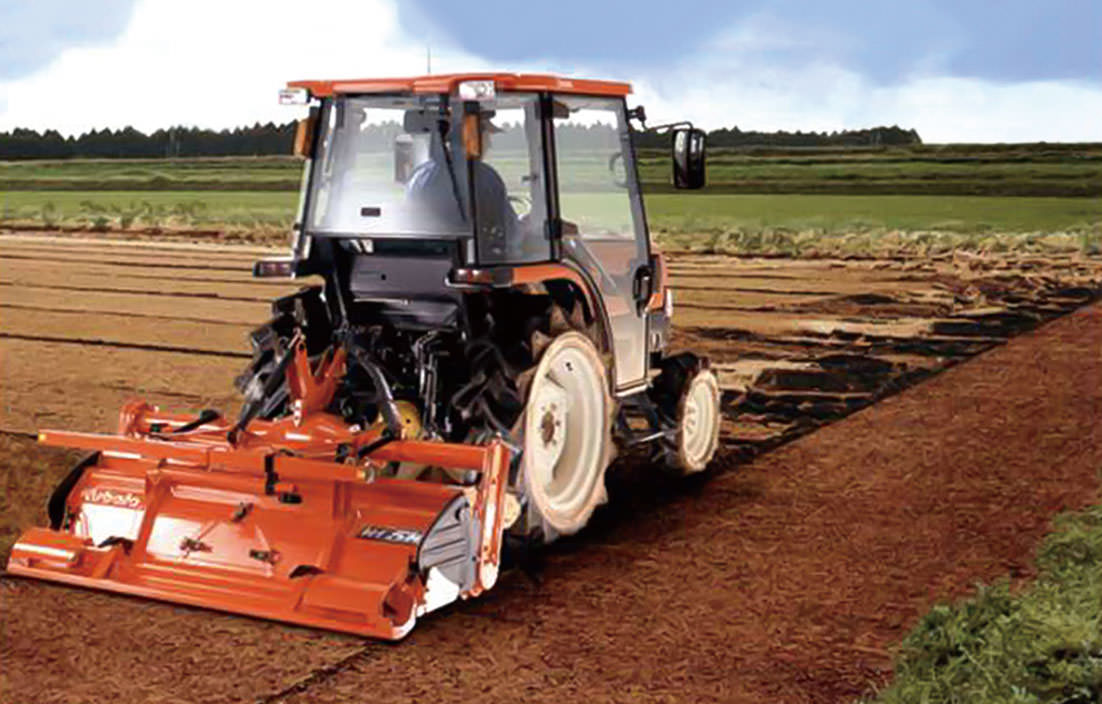
1970-1980s
The Monroe Sensation.
Producing Over One Million Tractors
Tractor
“Monroematic” plows leveled and evenly without reducing speed
Applying mechatronics, Kubota continued to lead the industry. The “Sunshine Monroematic”, which swept the industry and became the driving force for surpassing the total production of 1 million tractors, was a combination of electronic control system and hydraulic technology and brought new value to the agriculture field.
From a Time of Rapid Growth to a Time of “All Japanese Are Middle-Class” Mentality. Increasing Diversification of Lifestyles and Needs for Agricultural Machinery
As the period of rapid growth came to a close and the use of agricultural machinery had widely spread throughout the country, the Japanese lifestyle diversified and need for diverse equipment and features also increased accordingly. At that time, the government implemented the second rice field acreage reduction policy, and the demand for agricultural machinery had slowed down. In order to flexibly respond to the different needs without increasing cost, Kubota switched its production system to small-scale manufacturing of different types of equipment. It implemented advanced technology and manufacturing equipment, applying mechatronics, and greatly improved its facilities and cost performance. The Tsukuba plant, which most effectively automated its facility, was chosen as one of Nikkei Newspaper’s “100 Superior Trend-Setting Offices for Factory Automation.”
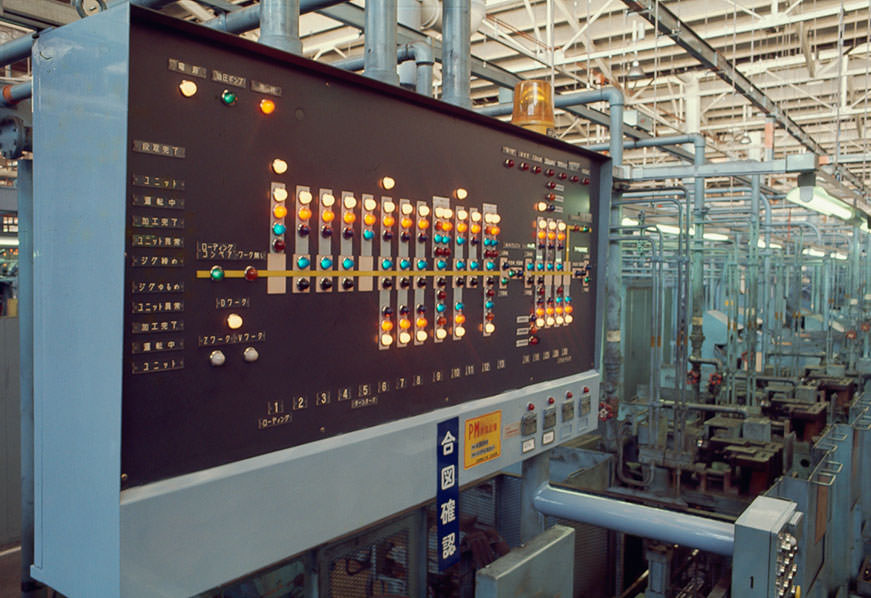 A centralized control monitor installed in the Tsukuba plant
A centralized control monitor installed in the Tsukuba plant
Developing New Products that Meet the Changing Times and Customers’ Goals. Creating a “Monroe Sensation” in the Market
As the government promoted the conversion from rice to barley and soy cultivation, Kubota invented an innovative tractor. In order to prepare good soil, undulating paddy and dry fields must also be tilled evenly. Traditional tractors tilted according to the tilt of the land, making it difficult to till evenly, unless you were an expert driver. Supporting farmers who faced such challenges, Kubota developed the “Sunshine Monroematic” Tractor in 1981. It combined electronic control system and hydraulic technology, realizing automatic leveling of the implement. Even if tractors tilted on bumpy fields, this product enabled even tilling and caused a sensation in the agricultural machinery market.
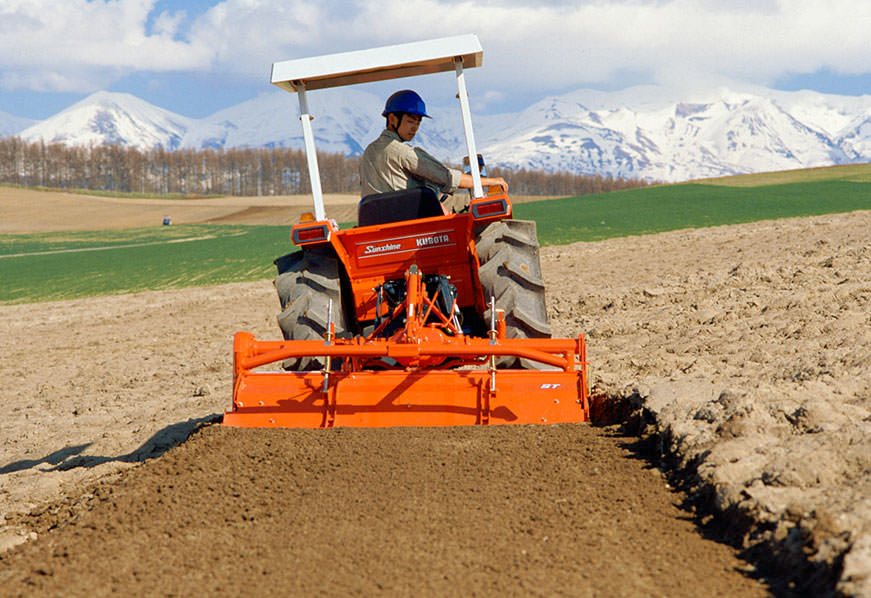 Applying cutting-edge electronic control technology of the time,
Applying cutting-edge electronic control technology of the time,
we invented the Monroematic mechanism that automatically levels the implement on uneven surfaces
Leading the Industry in the Mature Market by Applying Mechatronics; Reducing Farmers’ Workload One After Another
In order to create new demand in the mature market, Kubota utilized advanced technology such as mechatronics, which it had developed through the years, leading the industry through innovation. In 1983, after the Monroe sensation, it developed reversible type tractors with low fuel consumption. Implements can be mounted on the rear side of these tractors, realizing the function that is same as in the front side. They were widely used for paddies and dry fields as well as for minor public works and snow-plowing. The company also developed a microcomputer-controlled “Auto Monroematic” system and Bi-Speed Turn, which prevents damages to the headlands. Both were realized by Kubota’s culminating wisdom, based on the desire to help reduce farmers’ workload.
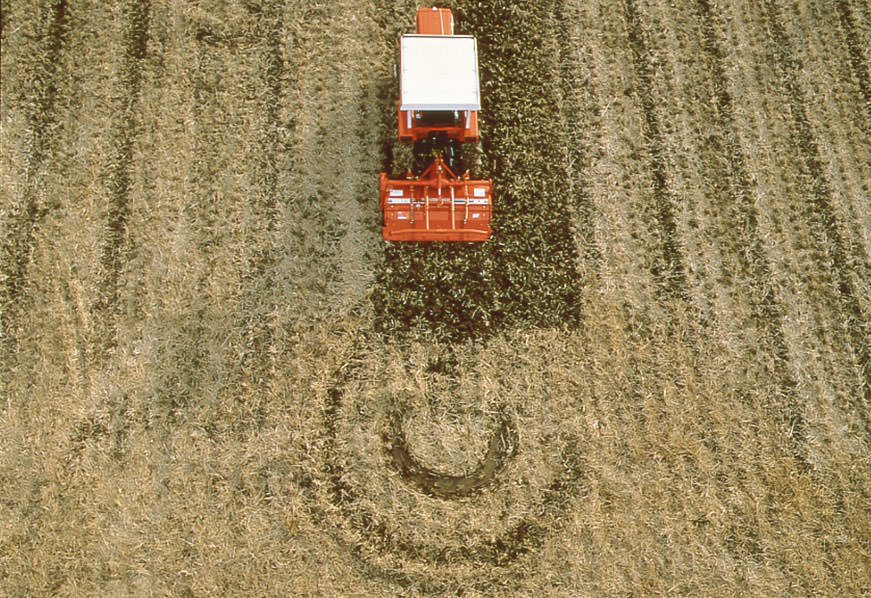 “Bi-Speed Turn, minimizing the turning radius
“Bi-Speed Turn, minimizing the turning radius
and preventing damages to the headland
Pursuing Customer Needs, High Performance, and Design Producing Over 1 Million Tractors
In 1984, Kubota’s production of tractors reached 1 million. We continued to release big hits providing excellent performance, one product after another. In this year, the company developed the RX2450 Combine Harvester, which automatically controls reaping height using ultrasonic sensors. It also developed the AX60 Combine Harvester for harvesting rice, barley, soy, and buckwheat, responding to the government’s policy to promote alternative crops and introduced the microcomputer-mounted R1 Series. The evolution of tractors was also prominent, as it introduced Saturn X24, which realized high performance with low cost, and Aste A19 for suburban farmers, winning the Ministry of International Trade and Industry’s Good Design Awards. Thus, Kubota continued to create new demands for agricultural machinery.
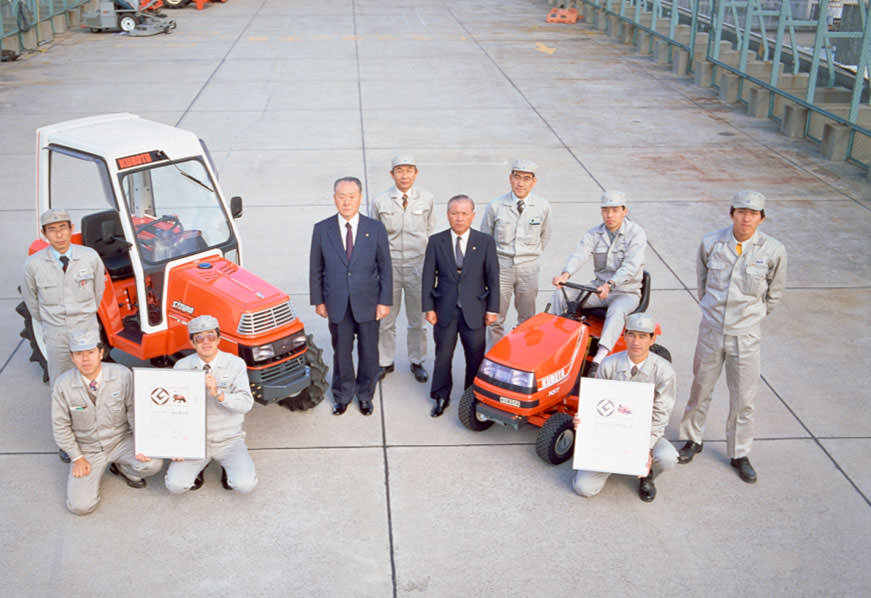 The team that developed Saturn X24 and Aste 19,
The team that developed Saturn X24 and Aste 19,
winning the Good Design Awards
2000-2010s
Supporting the World’s Agricultural Industry as a Global Leader
With the challenges of securing labor force, the fluctuating price of rice, and the rise of fuel, fertilizer, and pesticide costs, the reduction of operation cost had become an urgent issue for domestic famers of all sizes. Kubota, which, by this time, had become the industry’s global leader, developed standard-setting new series and expanded its support to farmers around the world.
Scroll down
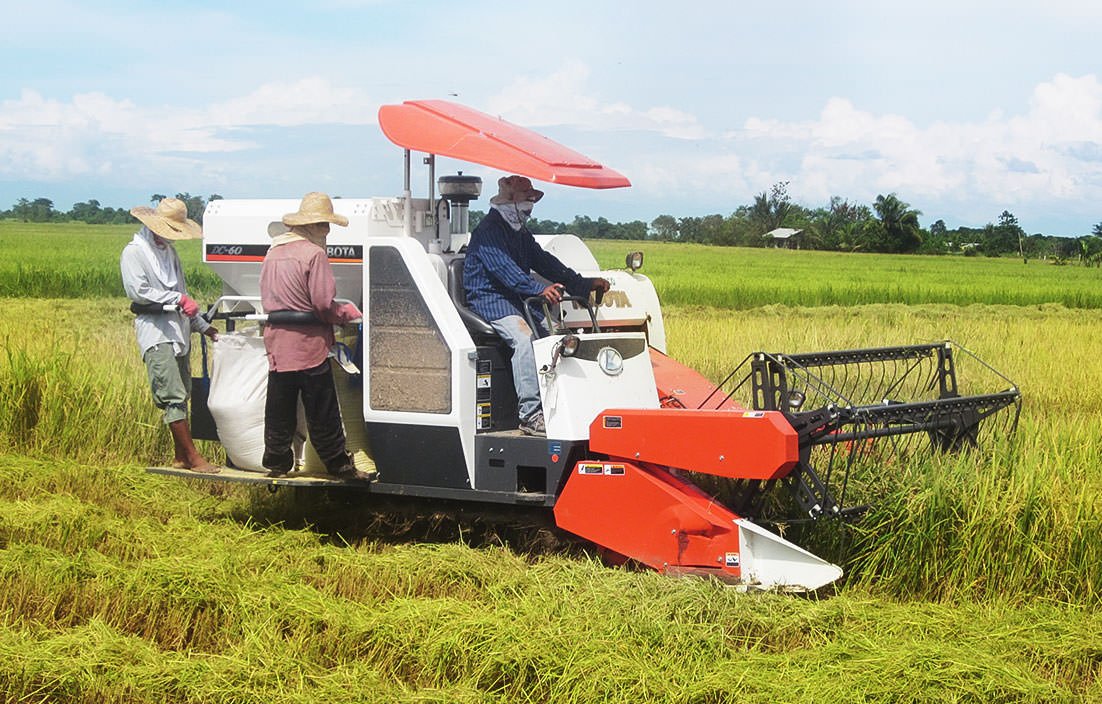
2000-2010s
Clean and Fuel Efficient. Products
Committed to Supporting Farmers
Around the World
Tractor, Combine
Kubota’s combine harvester supporting rice farming in the Philippines
With the decline in labor force population and drop in rice price, the reduction of operation cost became an urgent issue for Japanese farmers. At the same time, with an aspiration to support famers not only in Japan, but also around the world, Kubota advanced to provide solutions to problems both inside and outside the country.
Satisfying Polarized Market Needs and Developing Environmentally Friendly Machinery Competitive in the Global Market
As the Japanese government implemented an agricultural growth strategy, due to the rapid decrease in and aging of the workforce, requests from farmers increased for agricultural machinery that provided improved efficiency and cost reduction. As interest in management increased among the farmers, the difference in demands between fulltime farmers and part-time farmers became clear. We needed to strategically develop large-scale machinery with emphasis on functionality for the former and small-scale machinery with high performance but lower cost for the latter. Kubota, which adopted a common group-wide corporate philosophy, the “Kubota Global Identity,” will carry on with its approach to contribute to solving problems outside Japan.
Newly Released a Combine Harvester with a Common Design for Asian Countries. High Standard Performance and Durability, Clean and Low Cost
In 2010, Kubota released the Aerostar World Combine Harvester, which provided minimum required features while maintaining high standard performance at a lower cost than the existing domestic model. This excited the farmers as well as the domestic market, which had to reduce production cost, due in part to the drop in rice price and the rise in fuel price. With the introduction of this combine harvester, which had the advantages of high standard performance, durability, simplicity, and low cost—the absolute requirements for selling products in Asia—, together with the vision of overseas expansion, Kubota went on to develop its line of World Series products responding to diverse needs and scales.
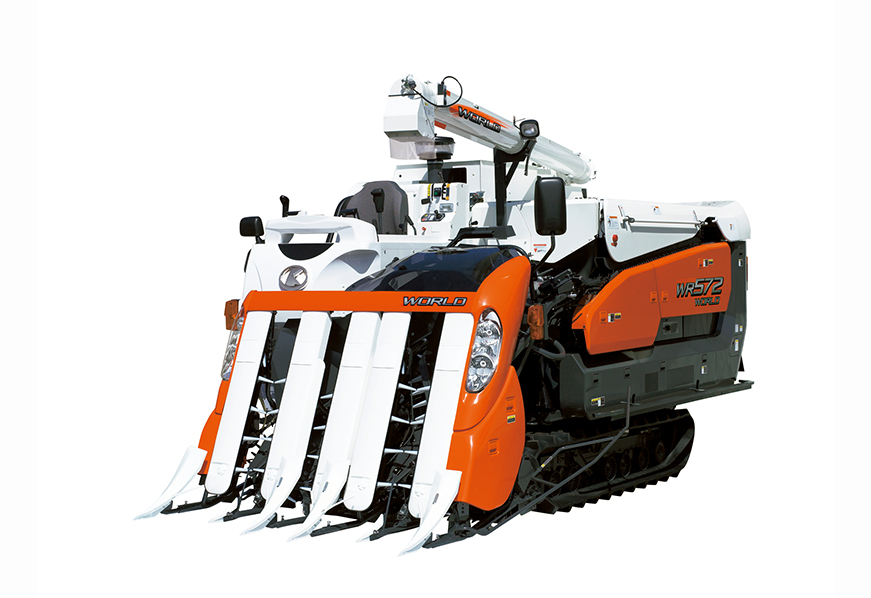 Aerostar World Combine Harvester released in 2010,
Aerostar World Combine Harvester released in 2010,
commonly designed for Asian countries
Simultaneous Worldwide Release of Multidimensionally Designed Tractors. Providing Solutions that Better Meet the Needs of Farmers and Agriculture
In January 2011, under the theme “We support vibrant farming!,” the company held the 64th Kubota Machinery Group Dealers Meeting, introducing the all-new “Grandom WORLD” tractors along with many other industry-leading agricultural machinery. Leveraging the scale of Kubota’s global presence, multidimensionally designed models were strategically developed to be released worldwide at the same time. Employing technologies we had developed throughout the world, we realized high standard performance, durability, and low cost. They were designed for large-scale dry-field, dairy, and livestock farmers expanding their businesses to own multiple tractors.
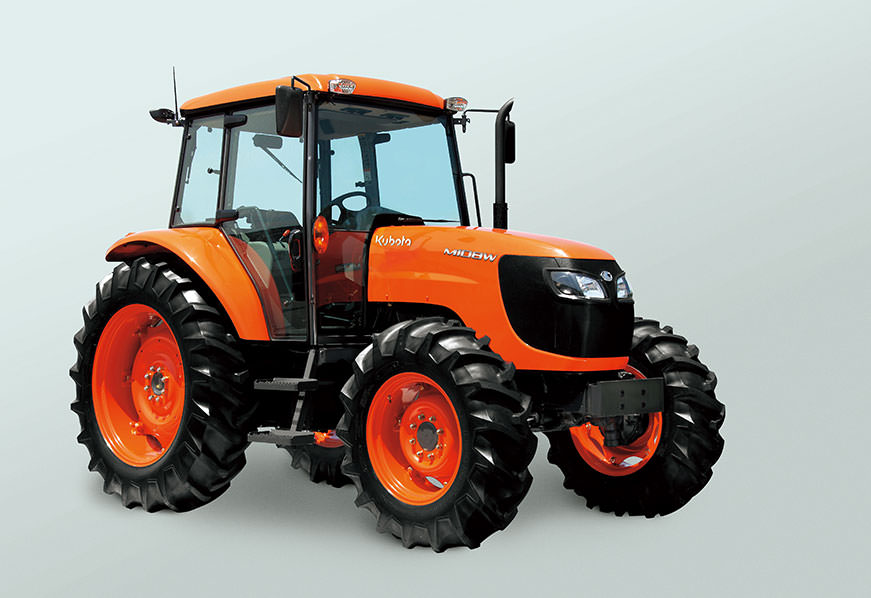 Grandom WORLD M108W contributes to agriculture
Grandom WORLD M108W contributes to agriculture
with superior performance and low cost
2016-
Opening a Bountiful Tomorrow with “Agriculture of the Future”
The future of agriculture made possible by today’s application of information and communications technology in various industries and sectors. Kubota, who has led the agricultural machinery industry for 40 years in order to realize farmers’ longtime dreams, created a futuristic solution by ‘visualizing’ agriculture.
Scroll down
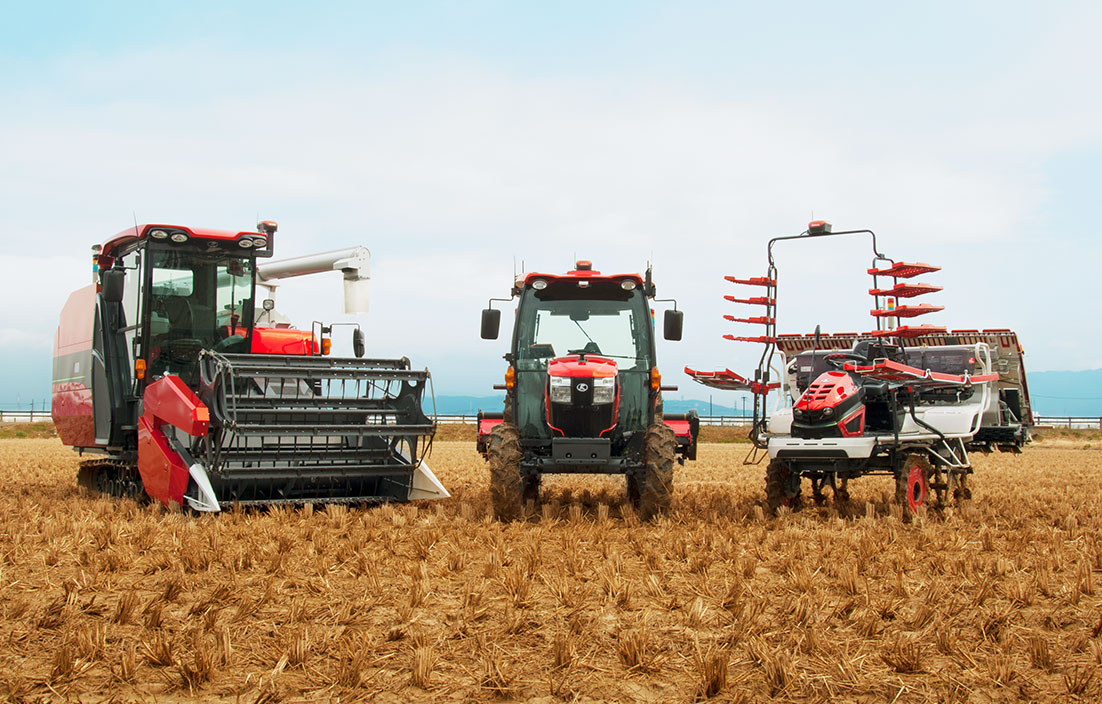
2016-
The Next Generation Machinery Made
Possible by State-of-the-Art Technology
and Standing By the Farmers
KSAS, Farm Pilot
Tractor, rice planter, and combine harvester with built-in auto-steering function presented in January 2017
To make unprecedented contribution, Kubota combines the industry’s greatest food production technology and its original ICT system. It is Kubota’s strength to stand by farmers, providing realistic solutions to the challenges they face. Leading the agricultural machinery industry, Kubota will develop the next generation machinery that creates a new dimension.
Changing Management and the Future of Agriculture through Visualization. The ICT Solution Age Started by Kubota
Creating solutions that open a new age or direction and bringing new value and inspiration to the lives of those who are involved in all scales of agriculture—Kubota continues to improve and develop its products with such passion. As information and communications technology (ICT) greatly affects the structure of society and economy inside and outside the country, Kubota is working on precision farming applying ICT. As Japanese farmers face decline in and aging of the labor force as well as challenges of improving cost and production efficiency, it has become increasingly difficult to revitalize the industry by repeating the skills learned from seasoned, high-skilled farmers or relying on intuition. Therefore, there is great expectation that supporting management that “scientifically interprets and visualizes agriculture,” based on solid data, will be a great force for the future.
The Industry’s First Combine Harvester that “Tells the Taste,” Realized by Integrating Kubota’s Broad Area of Research
We wanted to make possible, at the time of harvest, not only the measurement of crop yield but also the taste. In 2012, the Combine Harvester Division thus requested the Measurement System Division. If we could obtain data for the content ratio of protein and water, which determined taste, farmers could systematically improve their next year’s crop, adjusting fertilization. The road to development was not easy. The Engineering and Sales Division coordinated, repeatedly examined, and tested such crops as rice, barley, and wheat in 2-4 weeks intervals in farm fields throughout the country. They closely examined over 3,000 samples in 3 years. In 2014, when the Dynamax Revo Combine Harvester featuring a taste-yield sensor was completed, some claimed that this was what they had been looking for!
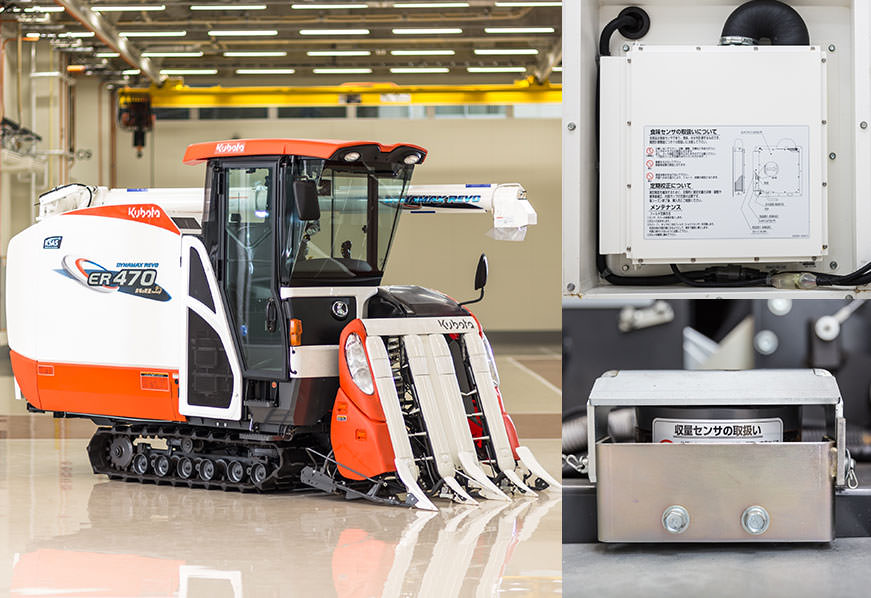 With the taste-yield sensor installed,
With the taste-yield sensor installed,
data on crop quality can be collected at the time of harvesting
Linking to Machinery, Providing Real-Time Support Onsite. KSAS Realizes Precision Farming.
In 2014, we launched the Kubota Smart Agri System (KSAS), an ICT support service, which uses big data collected by combine harvesters installed with taste-yield sensors. Farm managers, onsite workers, and Kubota’s Service Division are linked through this system, real-time. The system can instantly extract work record and management data as well as share the operation status of machineries. Its strength lies in two-way communication, where an onsite worker can make changes to work plans depending on the day’s field condition, providing feedback to the central station, thus, enabling flexible farm operation. KSAS continues to improve today in order for farmers to increase profit, produce crops with high product value, and manage a competitive farm.
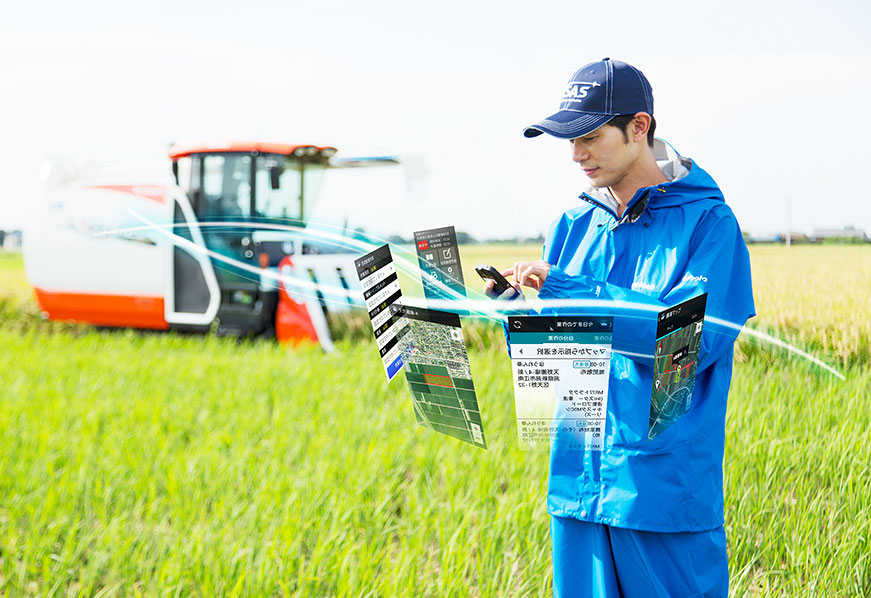 Using accumulated data, KSAS realizes efficient operation
Using accumulated data, KSAS realizes efficient operation
The Long-Awaited GPS-Mounted Machinery. Revolutionary Rice Transplanter Proudly Running Straight Forward in the Market and the Field
In 2016, Kubota sought to install GPS to its machinery. The first to be installed was the “Farm Pilot” Series rice transplanters with built-in straight-line keeper function. Among rice cultivation work, transplanting, in particular, is a process that requires high precision and advanced skills. With the aim of improving the efficiency and precision of young, inexperienced workers as well as elderly and female workers, who may require consideration for the amount of physical labor, Kubota installed an auto-steering function, which enabled easy transplanting of seeds while driving straight forward. It also contributed to cost and workload reduction, ensuring safe and comfortable working conditions. This product received the 59th “Ten Best New Product Award” (sponsored by Nikkan Kogyo Shimbun, Ltd.).
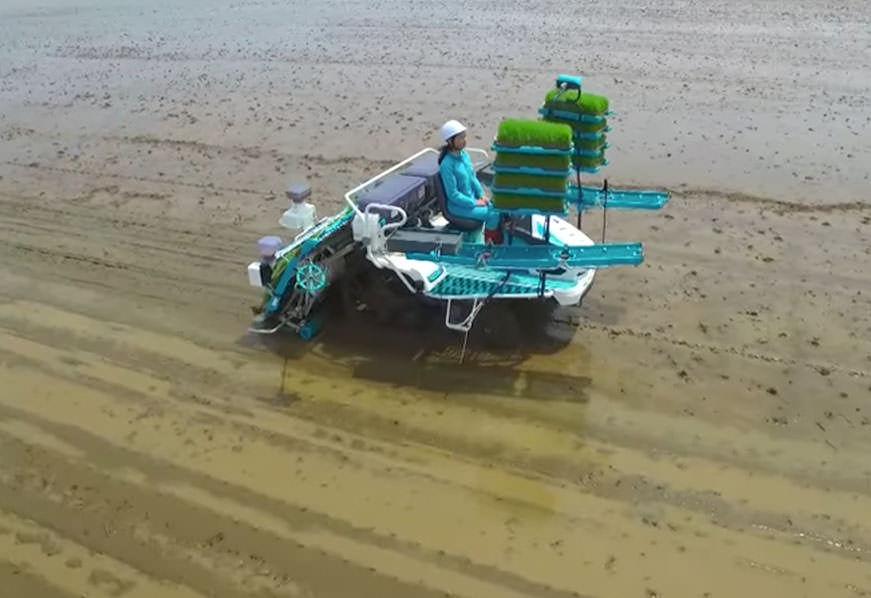 Auto-steering feature allows straight transplanting without proficient skills
Auto-steering feature allows straight transplanting without proficient skills
Future Agriculture Made Possible by Auto-Steering Technology. The Next Generation Machinery Changes Agricultural Norms
In Japan—which is experiencing an aging of its population—while the number of farmers decline, the area each farmer covers is expanding, creating a problem in securing workforce. In order to overcome the challenges of hiring seasoned workers, Kubota’s next strategy was to create self-driving machinery. In January 2017, we presented tractors, rice transplanters, and combine harvesters with built-in auto-steering functions. Machineries autonomously tilling, planting, and harvesting—this is the ideal future of agriculture. Kubota will continue developing technologies to spread these next-generation machineries as early as possible to realize labor-saving, high precision, and low-cost agriculture.
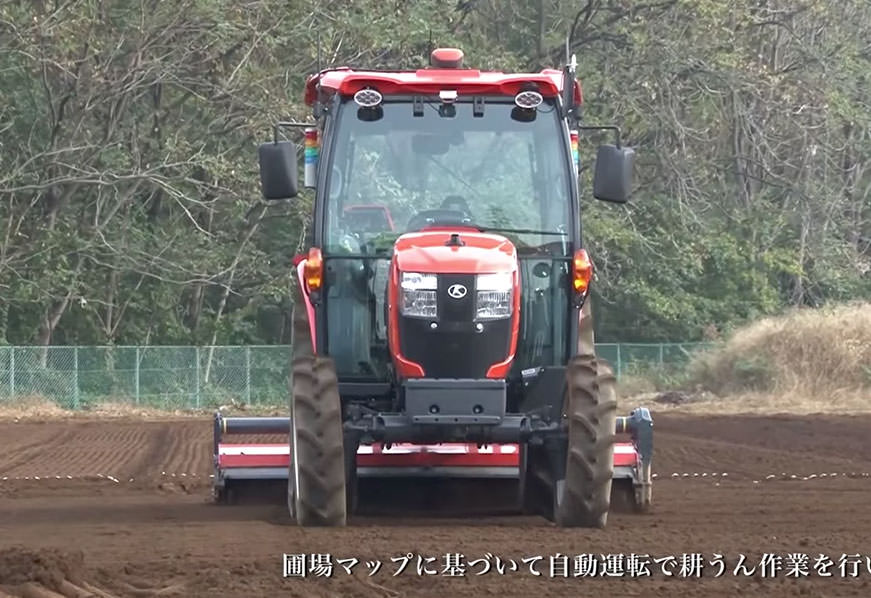 A self-driving combine harvester operating reaping work
A self-driving combine harvester operating reaping work
Kubota’s Vision for Agriculture, Shaped by Our Commitment to Standing By Farmers and to Next-Generation Technology
Standing by farmers over the years and refining our expertise for them, there is a vision for agriculture only Kubota can portray. One model for this vision is “Kubota’s Farm,” which demonstrates a sustainable farm management system in order to support Japanese agriculture. Kubota’s Farm—which has expanded to 15 locations around the country—will be a catalyst for spreading such farms that pursue the future vision of agriculture throughout Japan.
